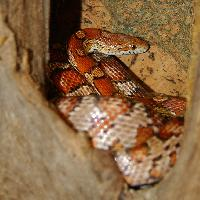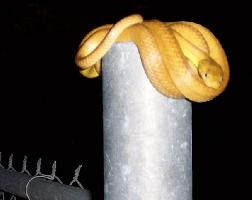
Poids et mesures
| Longueur | de 140 à 180 cm |
|---|
Description de l'animal
The Corn Snake (Pantherophis guttatus), also known as the red rat snake, is a North American species of rat snake that subdues its small prey with a constricting action. This species is predominantly found in the southeastern United States and is renowned for its adaptability to various environments, ranging from forested areas and meadows to abandoned buildings and agricultural fields. The Corn Snake is a non-venomous reptile, making it a popular choice among pet enthusiasts for its docile nature and relatively easy care requirements.Adult Corn Snakes typically reach a length of 24 to 72 inches (61 to 182 cm), with a slender build that showcases a striking pattern. The coloration of the Corn Snake is particularly noteworthy, with a ground color of orange or brownish-yellow and large, red blotches outlined in black running down the center of its back. The belly is checkered with white and black markings, resembling the kernel pattern of maize or "Indian corn," from which it derives its common name. The head of the Corn Snake is slightly distinct from its neck, and it features a spear-shaped pattern on the top.
Corn Snakes are primarily nocturnal but can also be found basking during the day in their natural habitats. They are adept climbers and swimmers, which enables them to pursue a variety of prey including rodents, birds, and their eggs. The diet of the Corn Snake plays a significant role in controlling the population of pest species, thereby benefiting the ecosystems they inhabit and agricultural interests.
Reproduction in Corn Snakes involves oviposition, with females laying clutches of 10 to 30 eggs, typically in the late spring or early summer. The eggs are deposited in warm, moist, hidden locations and hatch after approximately 60 to 65 days. Hatchlings are independent from birth, equipped with the instincts and abilities necessary for survival, including hunting small prey.
In captivity, Corn Snakes are known for their hardiness and can live up to 15 to 20 years with proper care. They require a controlled environment that mimics their natural habitat, including a heat source, hiding places, and a suitable substrate for burrowing. Their diet in captivity usually consists of appropriately sized mice, which are readily accepted.
The popularity of the Corn Snake as a pet has contributed to a better understanding and appreciation of this species, although it has also led to challenges, including the release of captive individuals into the wild, which can affect local ecosystems. Conservation efforts and responsible pet ownership are crucial to ensuring the continued survival and well-being of the Corn Snake in its natural habitat and in captivity.
In summary, the Corn Snake is a fascinating and beneficial reptile, characterized by its striking appearance, adaptability, and role in natural pest control. Its non-venomous nature and ease of care have made it a beloved pet, while its presence in the wild continues to contribute positively to the biodiversity and health of ecosystems across the southeastern United States.
Animaux similaires
Nouvelles photos d'animaux
Top 10 des animaux
- Dolphin gull (Leucophaeus scoresbii)
- Diana monkey (Cercopithecus diana)
- Moustached guenon (Cercopithecus cephus)
- Galápagos tortoise (Geochelone nigra complex)
- Russian tortoise (Testudo horsfieldii)
- Japanese macaque (Macaca fuscata)
- Stone loach (Barbatula barbatula)
- Common flying dragon (Draco volans)
- Greek tortoise (Testudo graeca)
- Vendace (Coregonus albula)


